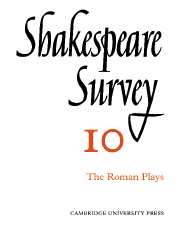Book contents
- Frontmatter
- Shakespeare’s Roman Plays: 1900–1956
- Shakespeare’s ‘Small Latin’—How Much?
- Shakespeare and the Elizabethan Romans
- The Metamorphosis of Violence in Titus Andronicus
- From Plutarch to Shakespeare: A Study of Coriolanus
- The Composition of Titus Andronicus
- Classical Costume in Shakespearian Productions
- Shakespeare’s Use of a Gallery over the Stage
- Lear’s Questions
- “Egregiously an Ass”: The Dark Side of the Moor. A view of Othello’s Mind
- Shakespeare in Schools
- Shakespeare Festival, Toronto, Canada
- International Notes
- Shakespeare Productions in the United Kingdom: 1955
- Drams of Eale, A Review of Recent Productions
- The Year's Contributions to Shakespearian Study 1 Critical Studies
- 2 Shakespeare’s Life, Times and Stage
- 3 Textual Studies
- Books Received
- Index
- Plate Section
Lear’s Questions
Published online by Cambridge University Press: 28 March 2007
- Frontmatter
- Shakespeare’s Roman Plays: 1900–1956
- Shakespeare’s ‘Small Latin’—How Much?
- Shakespeare and the Elizabethan Romans
- The Metamorphosis of Violence in Titus Andronicus
- From Plutarch to Shakespeare: A Study of Coriolanus
- The Composition of Titus Andronicus
- Classical Costume in Shakespearian Productions
- Shakespeare’s Use of a Gallery over the Stage
- Lear’s Questions
- “Egregiously an Ass”: The Dark Side of the Moor. A view of Othello’s Mind
- Shakespeare in Schools
- Shakespeare Festival, Toronto, Canada
- International Notes
- Shakespeare Productions in the United Kingdom: 1955
- Drams of Eale, A Review of Recent Productions
- The Year's Contributions to Shakespearian Study 1 Critical Studies
- 2 Shakespeare’s Life, Times and Stage
- 3 Textual Studies
- Books Received
- Index
- Plate Section
Summary
The greatness of King Lear is of a kind that almost disables criticism: in it, Shakespeare has so reconciled opposites as to make it difficult to frame any valid statement about the nature of the play as a whole. The total impression is one of primitive simplicity, of solid rock unfretted by the artist’s tool, but whenever, in studying it, the mind is visited by some small insight into its pattern (for of course it is patterned), further reflexion swiftly brings about a rush of critical excitement over the widening significances of what seemed at first a detail of the design, and this not once but many times; life is not long enough fully to explore King Lear. These repeated experiences of the play should inure the critic to the idea that whatever element of its design seems at any given moment most fascinating it is none the less merely one element among many, and the critic will do well to think of himself as the groping speleologist who traverses, astonished, one only of the many levels of that rock whose hidden intricacies are no more impressive than its simple mass. It is the purpose of this article to consider Lear’s habit of asking questions, and though this (at the moment) seems to me of fundamental importance in the play, it must be stressed that commentary on them is made in mindfulness of the fact that the play is inexhaustibly patterned, and any act of critical consideration of its patterns must be at best limited and in the last resort less true to the play as a whole than a perception of the final unified simplicity of its effect—or, one should perhaps say, of the powerful illusion of simplicity which the play’s patterns promote and subserve.
- Type
- Chapter
- Information
- Shakespeare Survey , pp. 90 - 97Publisher: Cambridge University PressPrint publication year: 1957
- 1
- Cited by

